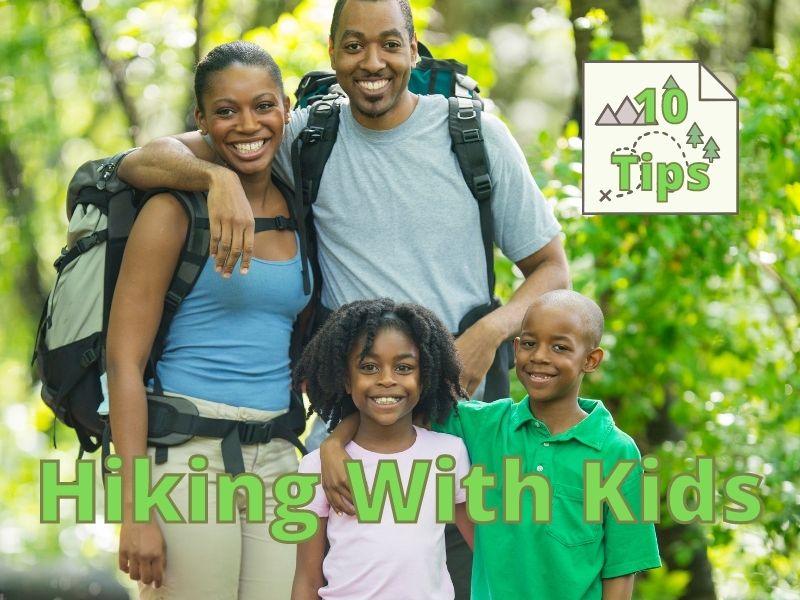Kids can get distracted easily. It’s helpful to establish guidelines for what to do and what not to do before you go. One way to do this is to pre-plan your hike before you go. You can tell your kids what to expect and what they need to do during the hike; that way things will go a bit smoother.
When hiking with kids you need to be prepared both physically and emotionally. This list of tips shows what you’ll need so you are prepared.
- Pick an Enjoyable Trail
- Plan the Hike With Your Kids
- Set Expectations for the Hike
- Keep Your Kids Safe During the Hike
- Plan What You Will Eat
- What to Talk About on the Hike
- Having Fun on the Hike
- Teach About Respecting Nature
- Timing How Long to Hike
- Give You Child Positive Feedback
Once you’ve hiked with your kids a couple of times, you can figure out what went well and what needs to happen next time. Just remember that the journey is what’s most important for kids, not the destination.
1. Pick an Enjoyable Trail When Hiking With Kids
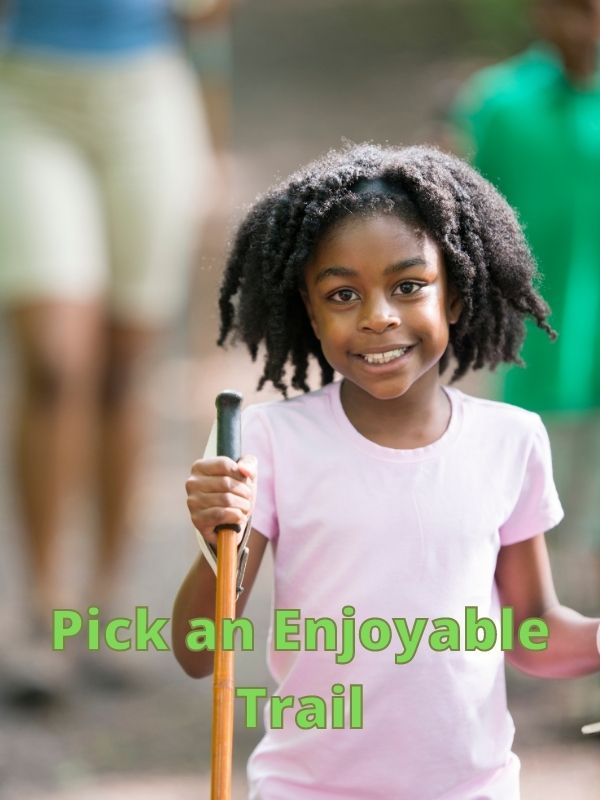
Children need to have a good experience in the first couple of times when going hiking, to want to go hiking in the future. One way to do that is to choose a trail that is enjoyable to hike on.
Kids want to explore, find, look at, investigate, touch, and ask questions. If you can encourage this curiosity in them as you hike.
You might find that you’re not hiking so much as you are finding things and exploring, and your kids will likely enjoy their hiking experience much more.
Trudging from point A to B isn’t any kid’s idea of fun unless there are things to look forward to. Having a plan in place for some fun experiences and downtime is important while hiking with kids.
One way to have a good time on a hike with kids is to find a wooded trail. This isn’t always possible, but if it is warm to hot, having shade will make the hike more pleasant.
Find an area that has plenty of shade and decide which path you will take. A fairly level trail is a good place to begin when hiking with kids. They will be able to focus more on the experience than on just hiking.
Sometimes you can have some steeper inclines. just as long as the kids have a chance to rest and the hike isn’t too long. A trail next to water can be a fun way to enjoy the hike more. Water offers a place to cool down, explore, and have a more enjoyable experience.
If you have found a good trial, the next step is to get prepared mentally and gather any supplies you may want and need.
2. Plan the Hike With Your Kids
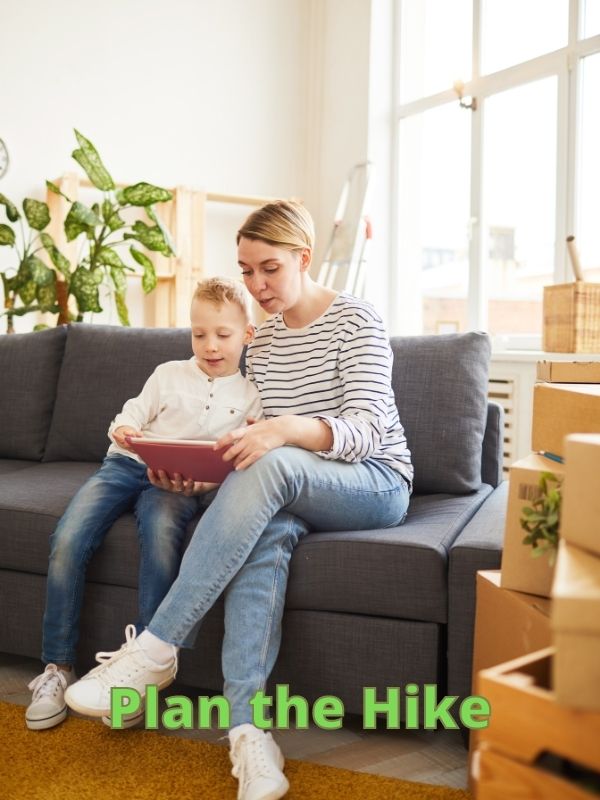
If you can make your children a part of the planning process, they will feel more invested in the hike. You can give them 2 or 3 choices for where they want to go on the hike. Decide beforehand what hiking trails are best for your kids.
Ask them questions about how long they would like to go. If it’s their first time and their young start with 30 minutes to 1 hour. Ask them if they want to go for a shorter time or a longer time. You can show them on a map where a shorter distance is and a longer distance.
You might want to explain time in terms of how long a TV show takes. A short show or a longer show is about how long the hike will take.
If you are planning to make a day trip of hiking, plan lots of downtime activities with your kids so they can have time to rest, eat, investigate, and play. Then you should be able to hike longer distances and still have a good time.
As you hike you can gauge their level of interest and tiredness. Try to avoid long distances, hot days, cold days, muddy trails, too many mosquitos, and steep trails.
Some children may have a preference for which day in the future that they would like to go hiking. Pick two days and ask if they have a preference. Sometimes kids don’t care, but other kids will want to have a choice of which day they would like to go on.
Plan out any food choices with the kids, the clothing they will wear, the gear they will bring if you need water bottles, and who will be carrying these items.
3. Prepare Your Child’s Expectations for the Hike
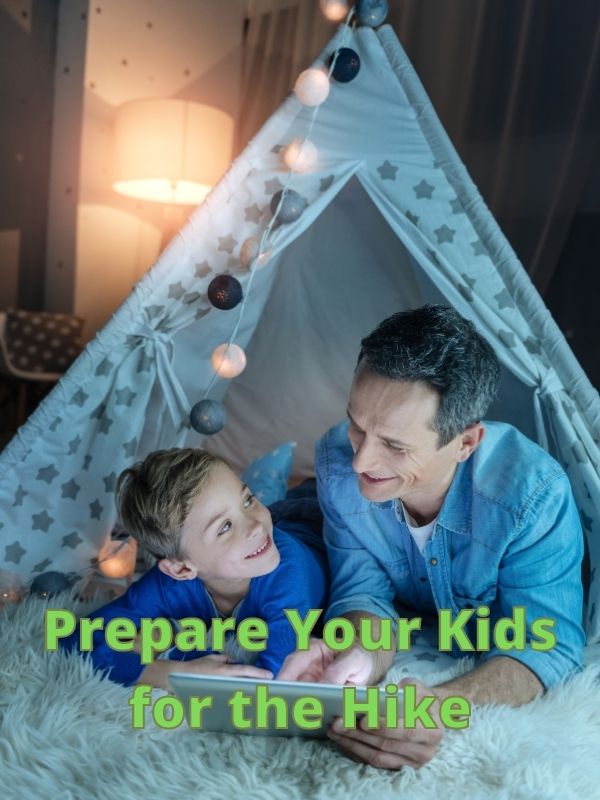
Going on a hike can be a simple or complicated matter. One way to ensure that the hike goes smooth is to talk about it before you go.
Your kids will want to know what to expect, so try to be as clear as possible about where they will be going, what to expect on the hike, and what the plan is along the way. Try to avoid being too vague or giving inaccurate information.
That’s why having a specific plan for exactly what you will be doing on the hike and which hiking trail you are taking is important.
For children, expectations are a big part of the experience. Some children may feel let down if they don’t feel like their expectations have been met, and they will be miserable the entire hike.
Instead, be clear and factual. You can say we are going exploring. Or you can choose not to say anything, and say we’re going to this location.
If you want to avoid your children being let down, you could say you don’t know what it’s like. You could ask them what they like about going to new places out in nature.
4. Keep Your Kids Safe During the Hike
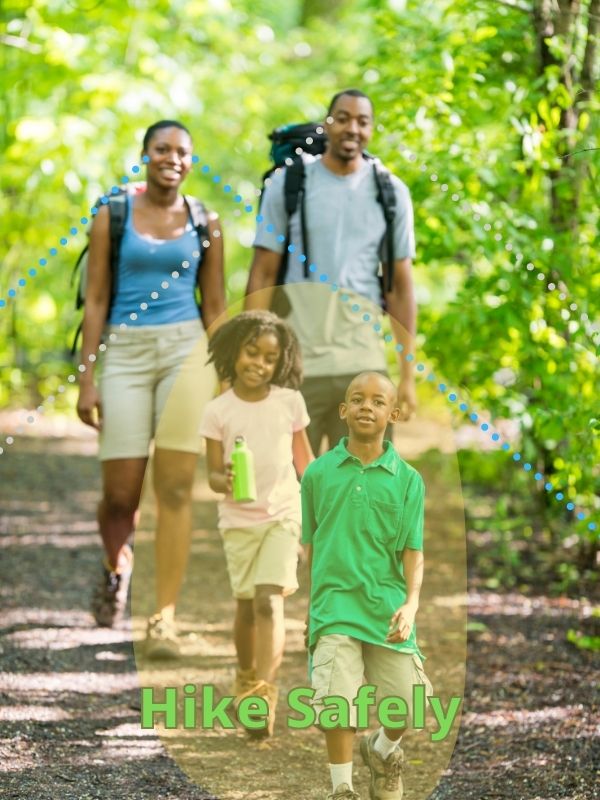
One topic that should be at the top of the list to talk about with your kids is safety. They need to know what plants and wildlife to be aware of, and what to do while on the trail.
Most hikers get hurt because of slipping or falling. Having a parent’s help to avoid steep falls is important when there’s a steep drop-off.
Getting lost on a trail can happen. It happens to experienced hikers as well as children. Children should know what to do if they are separated from their parents.
Discuss with your children your hiking expectations and what might be the consequence of not following safety guidelines.
Some safety topics to discuss are:
Maintaining A Close Distance. An adult can help a child who’s about to fall when they are crossing a stream, a rocky area, or a drop-off. Children are most safe within a 3-foot radius of their parents.
If the trail presents little danger, make sure you feel comfortable with your child going further away, and always make sure your child and you can both see each other.
Exploring. If your child likes to be independent and wants to go out and explore, make sure to be specific about your rules for safety and the consequences for not following established safety rules.
That’s why it’s a good idea to find safer trails for more adventurous children. Setting expectations about when and where they can explore and climb will help both children and parents have a better experience.
Animals. Children should be aware of what animals they may encounter on the trail and what to do when they find them. A curious child might see a small snake or lizard and want to pick it up.
Try to set guidelines for what is OK to touch and what they should not touch. Animals on the trail should be giving plenty of room and should avoid any human contact.
Decide if you need any mosquito repellent. You can wear pants and a long-sleeve hiking shirt and apply the repellant to your clothing, instead of you’re skin if you’re worried about the chemical in the spray.
Plants. If there are poisonous plants, you can teach your children to look out for them and avoid contact.

Poison Ivy
This shrub-like plant is found in the continental United States and can be found in almost any area with water.
It can look like a vine, it has three leaves to a stem and the leaf edges can look jagged to smooth at times.
It can cause a rash that can be very itchy.
Poison Oak
Poison Oak is easier to identify than other poison plants because of the 3 leaves on each stem and rounded edges on each leaf.
Found in North America, they are shrub-like plants that can climb like a vine at times.
It causes a rash when it becomes very itchy.


Poison Sumac
Found in the United States. This tree-like shrub can grow about 30 ft tall and can cause itchy burning skin.
It is usually found in wet areas. You may see it as a bush or a tree-like plant.
There are varying numbers of leaves on each stem that can reach about 12 leaves.
You’ll notice each pair of leaves has a space between them and the leaves have smooth edges.
Walkie Talkies. Teens may want to hike ahead or go off with a friend. Having a two-way radio or walkie-talkie can be helpful to ensure safety for more experienced and responsible kids.
I would be sure to train children to use the walkie-talkies before they go on a hike and use them. Make sure they know about what to do and what not to do, so both radios are on the correct channel and turned on at all times.
I am planning on getting these two-way radios (AD) in the future if I need to talk to anyone while camping or hiking.
They have a lot of great features and can even be fine with most kids with a little bit of practice and responsibility.
If your child can’t handle a walkie talkie an emergency whistle (AD) is also a good idea.
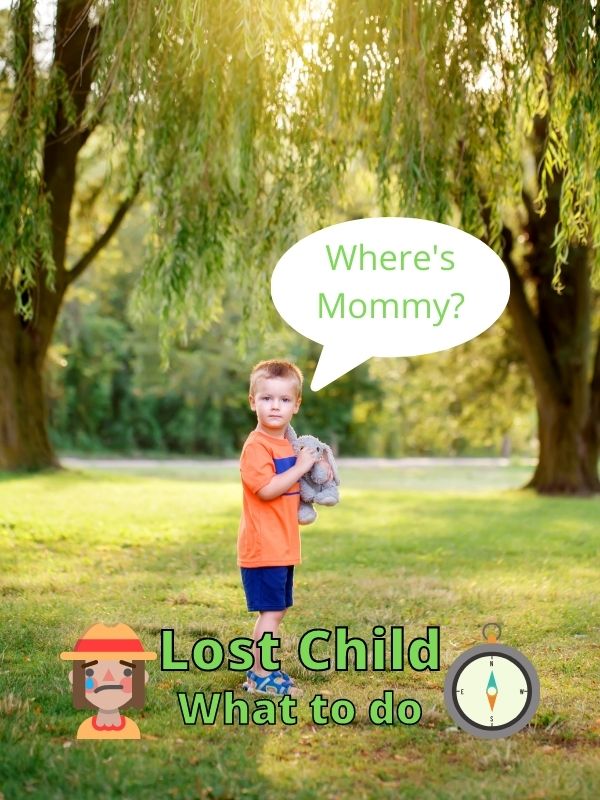
Getting Lost. Whether it’s in the store, on a vacation, or out in nature, kids can get lost easily. Going over a plan of what to do when they get lost is important. They should know what to do and practice it at least once before going somewhere where getting lost is possible.
What Parents Should Do
- Have a current clear picture of your child on your phone or a print with you.
- Remember what clothing they were wearing.
- Look around for a minute or call the police immediately. Each situation may call for different actions.
- Call the police. If there’s a park ranger station or fire station near it may help to have their numbers available as well. Some parents may want to enlist other people on the trail to help look for their child.
- I feel that most people can be trusted to help, although each parent needs to make their own choice about asking others for help and they need to instruct the volunteers what to do if the child is found.
- Look for your child. If there are two parents or adults, may a clear plan for what you will do. Think about where your child wants to go and where they would likely be.
- Make sure you have a signal on your phone to communicate with others about the situation. One parent may need to stay in one location while the other looks around.
What Children Should Do
- Ensure they have a whistle, phone, or walkie-talkie to help them communicate their location. A whistle is often the best choice for short ranges because it’s often easy to locate the direction of the sound.
- They should blow it three times then stop. After a few moments, they can repeat the three whistle-blow patterns. This tells the parents the child is lost. If they don’t have a whistle, they can shout their parent’s names.
- Make sure your child knows your phone number. They can ask someone to call you if they have a phone. Giving them the number on a paper is also helpful. You might want to make an identification card with your number and put it in their backpack.
- If your child is lost, explain to them that it’s best to stay where they are, if it’s safe, and wait for someone to find them.
- Explain what to do if a stranger finds them on the trail. Should they ask for help? This is usually a good idea.
- They should never go with a stranger unless it is a park ranger, firefighter, or police officer. They can ask the stranger to call their parents or call the police if they don’t have the parent’s number. They can also ask the stranger to find help, such as the park ranger if there’s no phone reception.
Clothing. When the trail is narrow, it’s a good idea to bring pants. You can avoid getting scratched and prevent any poisonous plant residue from getting on your legs.
If it’s a warm or hot day, shorts are very helpful. It’s a good idea to bring a couple of layers of clothing, for your upper body at least, so you can stay warm and cool down.
Remember to wear a hat, even on an overcast day, to prevent sunburn. If you have a small container of sunscreen, you can decide to use it if you need it.
Bring a large enough pack to handle all of the items you want to bring, and light enough clothing so it won’t be heavy.
An Injury. If your child falls or slips, you’ll need to have some type of first aid kit available. Most of the time bandages and sterilizing pads are all that is needed. Tweezers are also helpful for a splinter.
Sometimes an unexpected injury can occur. Make sure you have your cell phone for emergencies. Have a couple of larger gauze pads for larger cuts and scrapes. Having these types of bandages can help:
Elastic Bandage Wrap (AD)- To help with sprains and help support and sometimes prevent joint movement. You can also use cohesive tape which sticks to itself.
Waterproof Tape (AD)- To help keep dressing on the skin and covering any areas where you might have gotten a blister. You can also use athletic tape if you have any.
Don’t forget mosquito repellant if needed and bug bite lotion or spray itchy insect bites.
5. Plan Your Food and Water for the Hike
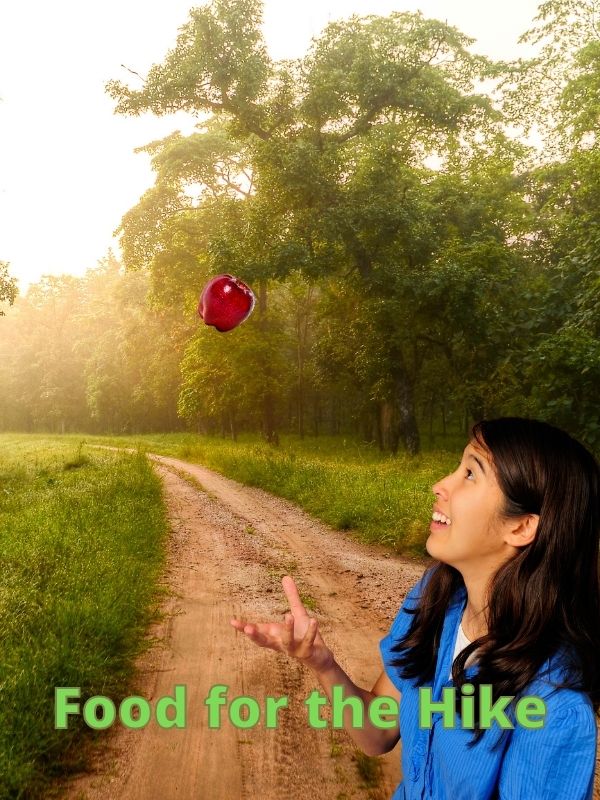
Not every hike requires food and water, but if you’re hiking for more than 30 minutes, it’s a very good idea to bring a backpack with supplies. Water is important to bring during any hike. During the hike, you might want to also have a snack if the kids get hungry.
Try to avoid getting sugary treats; this might impact some children more than others. Some children will focus less on the environment around them and may feel wired.
If you’re eating lunch on the trail, try to make it healthy. Have each child bring their own backpack, so they can carry their food. A water bottle, a sandwich, a fruit, and a vegetable will be fine for most children.
The more healthy choices the better. Then during the hike, you can eat a snack bar, not as a treat but as an energy source if needed.
Children get plenty of sugar in almost all the foods they eat. In recent years the American Heart Association decided to recommend that children 2 and under receive no sugary foods in their diet because it is linked to health problems later in life.
6. What to Talk About on the Hike
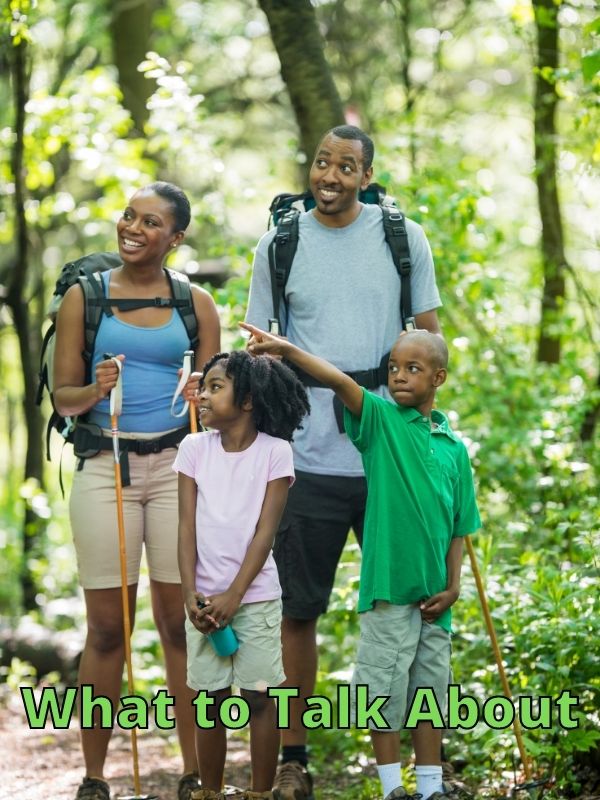
A hike is a good time to let go of stress and get closer to family. It starts by showing your focus is on your children and that you’re enjoying your time with them.
When you are on the trail you don’t need to talk at all, but letting your child know that you’re willing and able to listen and understand will go a long way toward building a trusting relationship, especially if there have been some tensions lately.
A good place to start a conversation when going on a hike is to check on your child’s comfort level. If you want your child to open up to you, being a good listener will help.
Start by asking some simple hike-related questions and do a good job retelling what you heard.
For example, you could ask “Are your shoed feeling comfortable?” If the child says they’re fine, you could respond by saying, “Sound like your shoes are feeling good.”
Some parents don’t want to go down that road, because they feel their child might start complaining, but it’s still a good place to start. If complaining occurs, try to acknowledge their feelings and remember to show that you heard what they said by repeating it in your own words. Most of the time that’s all that most children will need.
Then hopefully you can refocus their attention on the trail and talk about what they’re seeing and hearing.
Here are some things to talk about on the trail:
- Encourage them to talk about their interests (Toys, video games, TV, movies).
- Talk about their friends. (What they like to do together, what they like about them, their frustrations)
- Talk about their concerns.
- Animals and insects they see.
- Interesting looking rocks.
- What they notice about the trees and plants.
- What types of flowers do they notice?
- Weather patterns.
- How do animals survive in their environment?
- What is an ecosystem and cycle of life?
- What makes the plants grow and how they reproduce.
- The sun’s role in life on the planet.
- Fossils.
- The benefits of hiking.
7. Have Fun While Hiking

Sometimes children will lose interest in the hike. Ask them to look at the map and choose where to go next. You may want to stop and explore an area along the trail that your child shows interest in.
Try to help your child have fun exploring nature. Find some rocks to look at, sticks to hold, and leaves to touch. Maybe your child needs to take a break and make something. Ask them to see if they can make something with the leaves and sticks that are lying on the ground.
You could go looking for seed pods and try to find as many different kinds as possible. The same can apply to rocks, leaves, sticks, insects, etc.
Having fun along the way will make the experience much more meaningful for some children. Try to participate with them in activities where you can do something together.
Some ideas to try for fun are:
- Finding items in nature.
- Singing together.
- Making something from natural materials.
- A short race.
- Observing animals from a distance and watching their behavior.
- Using a hiking stick or pole.
- Climbing on rocks and logs when safe.
- Taking pictures of nature.
- Tag.
- Leapfrog – leap over each other like frogs.
- Kick the pinecone like a soccer ball, or try hot potato with the pine cone tossing it back and forth without holding it too long and without it touching the ground.
- Hide an object and say hotter or colder to indicate distance.
- Storytelling.
- I spy something, and the other person has to find it.
8. Respect Nature While Hiking
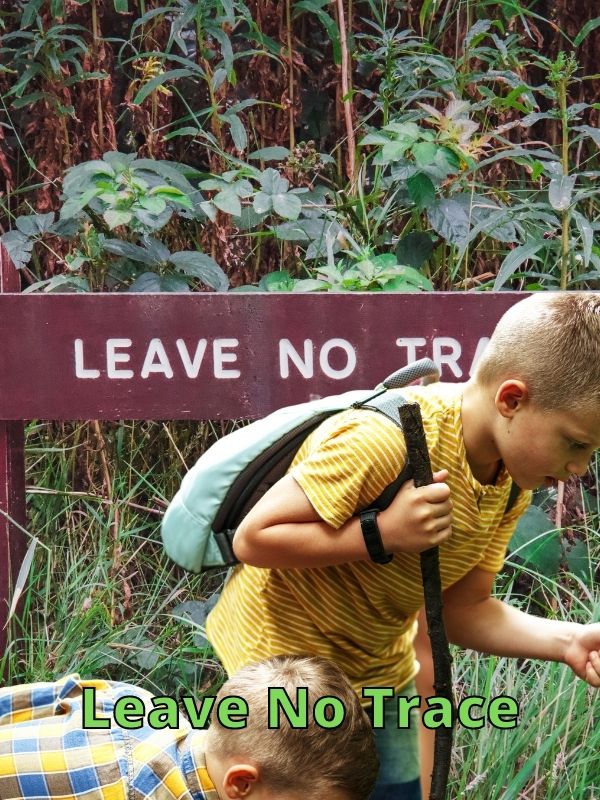
I have been to several places in nature where leaving trash on the ground is the norm. Once one person leaves trash, it becomes easier for the next person to do it. Soon, no one can enjoy the natural beauty of the area with all the trash around.
Teach your children about what happens when we leave our trash on the ground. Explain that plants and animals live here and the need for a healthy environment to survive.
In most state and national forests, you’ll see signs about leaving no trace that you were there. That means we can teach our children to pack their trash out with them and return items they’ve found back to where they were before.
9. Timing the Hike

Children of different ages will be able to handle different lengths of time hiking. Their interest levels may change along the way. The ultimate goal is to make it a good experience for them. Time their experience so that they don’t get overly tired, bored, or frustrated.
The first few times you hike with your kid, make it easy and for shorter time periods. After a while, your child may start to enjoy getting out into nature and wonder when the next trip will be.
Then you can start to increase your time a bit, keeping in mind their ability to enjoy the experience depends on their willingness and the activities that they will be engaging with during the hike.
Plan much more engaging activities for children 8 and under, so their interest level will stay higher. Try to forget about the need to get to the destination, and enjoy the moments along the way.
If your child is no longer engaged, then cut the hike short or give them a break to refuel their enthusiasm.
10. Give Them Positive Feedback During the Hike
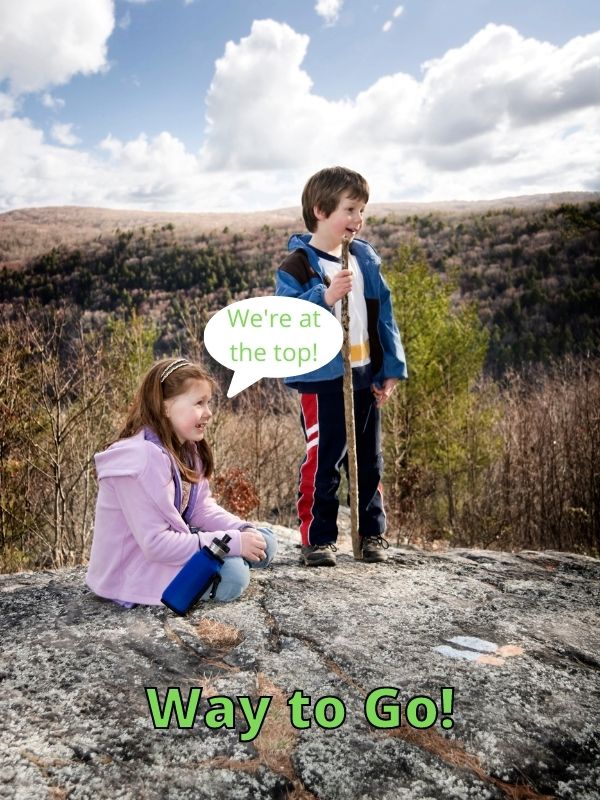
Make some mental notes about things that you liked about your child’s behavior during the hike. Mention one thing you like about their actions as you are hiking. Try to make it feel natural and not as a way to control behavior.
At the end of the trail and the end of the hike, show your excitement that you’ve finished the trail together. As you are traveling home you can mention all the things you liked and ask if what they thought of the hike.
Again while you’re going home, you can recall how you appreciate certain actions and behaviors that you saw them do along the trail.
Hopefully, this can be a time for parents and children to feel relaxed and grow closer through positive interaction. Children can start to increase their interest in the natural world around them and with more exposure will likely really start to love the outdoors.
Thanks for visiting Helpshoe.com
References
https://americanhiking.org/resources/hiking-with-kids/
https://www.outsideonline.com/2393022/how-to-hike-with-kids
https://campminder.com/go/27-summer-camp-activities-to-spice-up-the-summer-camp-atmosphere/
https://www.wta.org/go-outside/kids/how-to
https://www.parents.com/kids/safety/stranger-safety/what-to-do-if-your-child-gets-lost/
https://www.safewise.com/blog/what-to-do-when-your-child-goes-missing/

